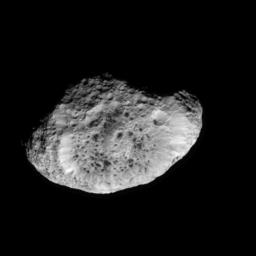
Flight to Hyperion animation
This movie sequence shows highlights of the Cassini spacecraft’s Sept. 26, 2005, flyby of the odd, icy moon Hyperion.
The sequence begins with Cassini at a distance of 244,000 kilometers (152,000 miles) from Hyperion, with the irregularly-shaped moon not yet filling the frame. From this distance, Cassini can see that strange, dark-floored craters dot this little world.
As Cassini continues toward Hyperion, it becomes apparent that the steep sides of the giant impact feature at the center have a "fluted" appearance. The walls of this feature appear to have experienced landslides that have partly covered the craters lining it.
With Cassini at an altitude of 18,000 kilometers (11,000 miles) above Hyperion, the movie then zooms-in on the large crater called Meri, which itself contains several smaller craters. The rim of Meri possesses icy outcrops, while its floor is filled with landslide debris and some of the strange dark material. The image scale at this point is about 215 meters (700 feet) per pixel.
Cassini pans across a landscape shaped by eons of impacts, revealing the dark-floored craters at high resolution. The trip to Hyperion ends as the movie pans away from the battered moon's darkened limb. Hyperion is 266 kilometers (165 miles) across.
The Cassini-Huygens mission is a cooperative project of NASA, the European
Space Agency and the Italian Space Agency. The Jet Propulsion Laboratory,
a division of the California Institute of Technology in Pasadena, manages
the mission for NASA's Science Mission Directorate, Washington, D.C. The
Cassini orbiter and its two onboard cameras were designed, developed and
assembled at JPL. The imaging operations center is based at the Space
Science Institute in Boulder, Colo.
For more information about the Cassini-Huygens mission visit
http://saturn.jpl.nasa.gov. The Cassini imaging team homepage is at
http://ciclops.org.

 Planetary Data System
Planetary Data System













